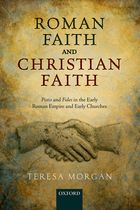Roman Faith and Christian Faith: Pistis and Fides in the Early Roman Empire and Early Churches

Roman Faith and Christian Faith: Pistis and Fides in the Early Roman Empire and Early Churches
Teresa Morgan
Oxford University Press 2015
- An interdisciplinary study locating Christian faith fully in its Greek, Roman, and Jewish contexts
- Multi-thematic – Connects the study of ‘faith’ with Christian ethics, ecclesiology, Christology, and eschatology
- A comprehensive study of the understanding and social operation of Greek and Roman pistis/fides, and of the origins and development of early Christian faith
- Provides a clear layout, helping readers to understand Graeco-Roman, Jewish, and Christian pistis/fides in themselves and relate them to each other
- Accessible – Key terms are transliterated and all passages of Greek and Latin are translated
This study investigates why ‘faith’ (pistis/fides) was so important to early Christians that the concept and praxis dominated the writings of the New Testament. It argues that such a study must be interdisciplinary, locating emerging Christianities in the social practices and mentalités of contemporary Judaism and the early Roman empire. This can, therefore, equally be read as a study of the operation of pistis/fides in the world of the early Roman principate, taking one small but relatively well-attested cult as a case study in how micro-societies within that world could treat it distinctively.
Drawing on recent work in sociology and economics, the book traces the varying shapes taken by pistis/fides in Greek and Roman human and divine-human relationships: whom or what is represented as easy or difficult to trust or believe in; where pistis/fides is ‘deferred’ and ‘reified’ in practices such as oaths and proofs; how pistis/fides is related to fear, doubt and scepticism; and which foundations of pistis/fides are treated as more or less secure.
The book then traces the evolution of representations of human and divine-human pistis in the Septuagint, before turning to pistis/pisteuein in New Testament writings and their role in the development of early Christologies (incorporating a new interpretation of pistis Christou) and ecclesiologies. It argues for the integration of the study of pistis/pisteuein with that of New Testament ethics. It explores the interiority of Graeco-Roman and early Christian pistis/fides. Finally, it discusses eschatological pistis and the shape of the divine-human community in the eschatological kingdom.